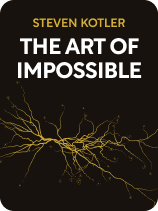

This article is an excerpt from the Shortform book guide to "The Art of Impossible" by Steven Kotler. Shortform has the world's best summaries and analyses of books you should be reading.
Like this article? Sign up for a free trial here .
What is Steven Kotler’s flow state? Why does it help you achieve your most difficult goals? How can you get into a flow state?
Bestselling author and journalist Steven Kotler wrote The Art of Impossible to share his step-by-step process for developing peak performance habits that will help you to achieve your most ambitious goals. Following Kotler’s process to achieve a flow state leads to better performance in all aspects of your life, including physical and mental performance.
Keep reading to find out Steven Kotler’s three steps for getting into a flow state.
Steven Kotler’s Flow State: The 3 Steps
Steven Kotler’s flow state, otherwise known as “being in the zone,” comes about when you’re so focused on what you’re doing that you feel completely absorbed by it. According to Steven Kotler, the flow state offers advantages that make working toward seemingly impossible goals feel both enjoyable and effortless. Physically, full engagement increases strength, endurance, and muscle reaction times and decreases sensations of pain, feelings of exertion, and exhaustion. Mentally, full engagement offers the following advantages:
- Increased levels of motivation and productivity
- Improved learning and long-term memory
- Enhanced creativity and innovative ideas
- Amplified feelings of satisfaction and fulfillment
- Heightened empathy and social awareness
- Enriched collaboration and cooperation
Step #1: Break Your Seemingly Impossible Goal Down Into Challenging Tasks
According to Steven Kotler’s flow state process, the first step toward creating your strategy involves breaking your seemingly impossible goal down into achievable tasks. Kotler argues that this process helps you prioritize your time and focuses your attention on what you need to do to make progress.
- Break your life mission down into large, ambitious goals. Then, break these large goals into a series of challenging but achievable daily tasks. For example, your first daily task toward achieving your goal to set up a distribution network for agricultural solar technologies might be to define what resources you’ll need to move forward. Your second task might involve creating a plan to acquire these resources, and so on.
Step #2: Set Your Schedule
Scheduling time for the tasks required to achieve your seemingly impossible goal is an important step for fully engaging in the flow state. Steven Kotler argues that setting aside blocks of time to accomplish your tasks and improve your skills produces the neurochemicals necessary to practice full engagement and amplify your focus and productivity.
- Set aside at least 90 minutes of uninterrupted time each morning to accomplish your daily tasks.
- Commit to this schedule even when you’re feeling stressed out or exhausted. This will train you to maintain focus during uncomfortable or difficult circumstances.
Step #3: Expand Your Knowledge and Capabilities
According to Steven Kotler, the third step toward creating your flow state involves expanding your knowledge and skill set so that you can continually exceed your capabilities and move closer to your goal. As we’ve discussed, Kotler claims that regularly learning new things encourages your brain to form connections between different ideas. This improves your problem-solving skills and your ability to come up with creative ideas. Further, the process of learning boosts levels of dopamine and norepinephrine in your system, making it easier to practice full engagement and build momentum toward your goal.
Tips for Finding Your Flow State
To achieve seemingly impossible goals, cultivate a positive attitude. Kotler argues that staying positive promotes a continual release of reward chemicals that alleviate stress and help you develop the resilience you need to overcome obstacles and sustain your momentum.
Here’s some recommendations for achieving a positive attitude while working towards your flow state, according to Steven Kotler.
Get in the Zone
Spend two to six hours each week pursuing recreational activities that fully engage you so that you can benefit from the pleasurable advantages that all six reward chemicals offer. According to Kotler, the more you practice being fully engaged when you’re not working toward your goal, the easier you’ll find it to be fully engaged when you are working toward it. For example, you feel fully engaged when you hike through the woods, complete jigsaw puzzles, and bake cakes. You spend two hours each week pursuing each of these three activities—totaling six hours of full engagement.
Be Grateful
Each day, write down 10 things you’re grateful for and take the time to feel good about each item on your list. To get into and stay in a flow state, Steven Kotler argues that taking time to feel thankful matters. Being grateful makes you feel more positive because it keeps you focused on what’s going well in your life. It also trains you to seek out positive information—a skill that helps you reframe problems and find solutions to overcome any challenges you face.
Exercise Regularly and Sleep Well
Spend three hours exercising each week and try to get at least seven hours of sleep a night. Kotler argues that staying active and sleeping well alleviates symptoms of stress and anxiety and increases your ability to maintain a positive state of mind.

———End of Preview———
Like what you just read? Read the rest of the world's best book summary and analysis of Steven Kotler's "The Art of Impossible" at Shortform .
Here's what you'll find in our full The Art of Impossible summary :
- A look at how some people can achieve seemingly impossible feats
- How to make your dreams more attainable
- A step-by-step process for developing peak performance habits






